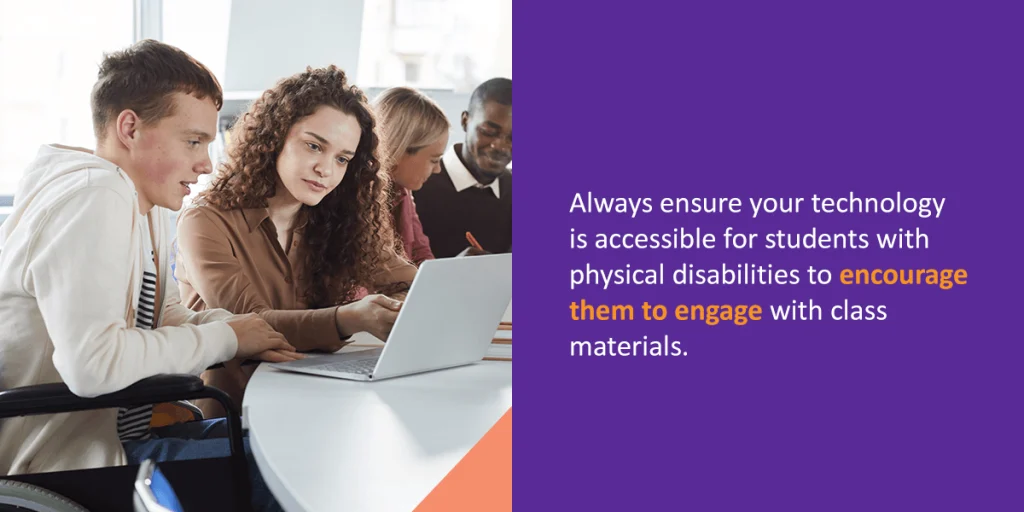



Equity is a crucial part of the academic experience for instructors and students. Professors must be able to adapt their lesson plans, assignments, and curriculum to fit each student’s learning style. Doing so will create an enriching environment for every learner and empower the instructor to better understand students and accommodate their needs so they can reach academic and personal success.
Equity in the academic sphere means individual factors don’t prohibit learners from achieving their full learning capabilities. Each student can access the same quality of education regardless of factors like culture, race, ethnicity, gender, immigration status, sexual orientation, religion, or socioeconomic status. Equity in the classroom also means ensuring each student can access the same resources and get the support they need to reach their educational goals.
Equality and equity are different concepts, although they can share similar practices. Equality in the classroom ensures that every student can access the same resources and materials. In contrast, equity in the classroom is the practice of providing each student the support they need for those resources and materials to be meaningful. While equality has a group focus and offers generic solutions, equity has an individual focus and is adaptable.
For example, equality in the classroom would mean every student has access to the same math test, pencils, and calculators. Equity practices attempt to give each student the support they need to do well. Examples include:
Equity creates enriching educational experiences for every student. This practice is essential in education because it:
Learning how to promote equity in the classroom takes time and practice. With each strategy, you’ll find more potential for results. You’ll be better able to determine what works and what doesn’t, allowing for seamless adjustments as you continue to teach. Take a look at these eight strategies for achieving classroom equity.
Changes in the classroom begin with you. Although you’re not deliberately excluding students, you can always actively seek new ways to promote equity. Examine your feelings and assumptions about holidays your students celebrate, immigration status, and where your learners or their parents were born. Becoming aware of any biases you have will help you build equity from the ground up.
Encourage students of every race and gender to participate in your courses. Building gender and racial equity in the classroom can look different in each environment, but here are a few things you can do to welcome more diverse students:
Technology has become integral to many classrooms because it can engage learners and appeal to many learning styles. However, it can impact students with physical disabilities. Some digital tools can hinder abilities such as dragging, clicking, and dropping screen items. Always ensure your technology is accessible for students with physical disabilities to encourage them to engage with class materials.

Everyone has a cognitive bias, and some people may voice their opinions inappropriately while relying on false information and stereotypes. You must address these comments and shut down insensitivity so every student feels comfortable and safe. Talk with students who make inappropriate remarks and explain how they’re harmful. Follow up with an administrator or counselor to determine the next best action steps if the behavior continues.
Each new class or semester is an opportunity to evaluate each student’s starting point. Early into each new session, run activities to encourage students to articulate their backgrounds and understand each other. This can help you better understand your students can foster an environment that welcomes differences.
An equity solution will accommodate each student’s needs. You must understand your students’ challenges and provide solutions for each barrier. There are many informal and formal ways to accommodate student needs in the classroom. Examples of formal equity practices in the classroom could be providing assistive technology or educational assistants. Examples of informal practices could include moving a student closer to the board or offering one-on-one support.
The stories your materials tell can make a big difference for your students. Many social sciences and humanities courses strongly focus on Western cultures, often featuring White, male, middle-class perspectives. Expanding your resources to include literature from other authors is an excellent way to incorporate discussions about culture, gender equality, immigration, and socioeconomic status.
There is no better way to foster equity than giving your students opportunities to voice their thoughts and feelings. Each student brings unique experiences to the classroom, and you can plan events and activities that seek their feedback, such as course evaluations and surveys.
Seek perspectives from students who don’t frequently share information and offer input in various ways to ensure that every student feels comfortable voicing their thoughts. Additionally, show your students that you’re listening to them by implementing changes and building your instruction methods around their needs and concerns.
Watermark turns data into action. When you choose our solutions, you can access software that empowers, evolves, and improves your institution and student success.
Watermark Student Success & Engagement empowers students to take charge of their education while making it easy to locate resources and support. With our solution, you can easily identify at-risk students and turn data points into action to get students back on track.
You can also pair Watermark Student Success & Engagement with Watermark Faculty Success for a comprehensive solution. This software enables you to align workflows with reviews so you can tailor curriculum and teaching practices to the changes your students want to see.
It’s never been easier to foster equity in the classroom. Request a demo of our software to experience the difference for your students.






























































































































































































































































































































































































